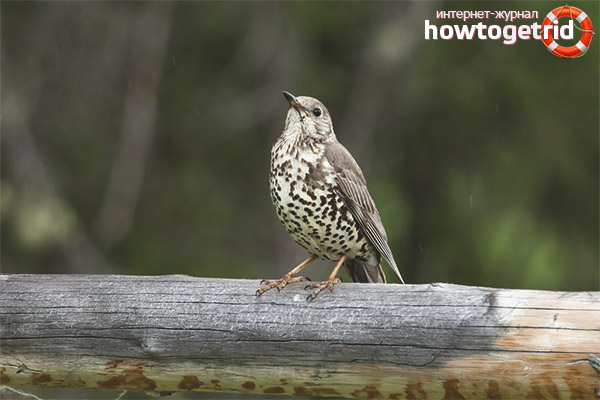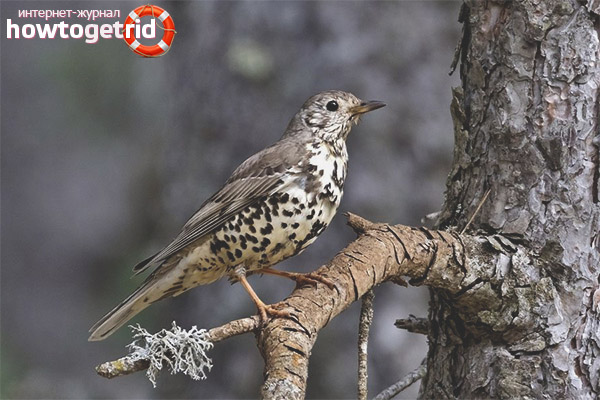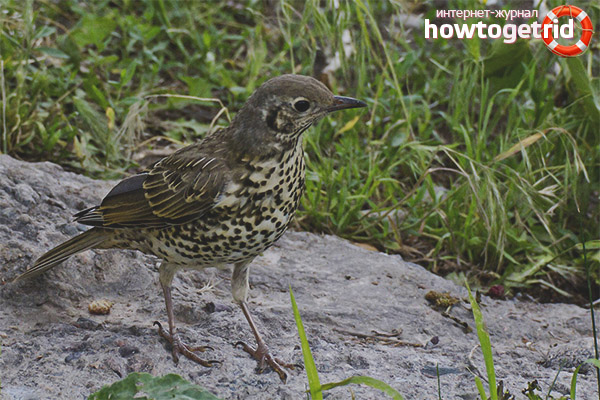The content of the article
Such a songbird such as the thrush Deryaba is considered the largest representative of the family of thrush, a group of passerines. Most often, this species of birds is found in Central Europe. In cold weather, the thrush often stays with human habitation, attracted by food that people place in specially equipped bird feeders.
The body length of the bird reaches 27-30 cm, weight - about 140 grams. The maturity of these birds occurs when a young bird reaches 1 year. The period of nesting and subsequent breeding is from the beginning of spring to the beginning of summer. The number of eggs in the clutch is up to 5 pieces. The duration of the incubation period is about 2 weeks. Hatching chicks are fed for about 20 days until they become independent and begin to get food for their own food. The average duration of blackbird thrushes in the conditions of natural habitat does not exceed 10-11 years.
Nearest related species, differences
The closest related species of the blackbird thrush can be attributed to such birds: the thrush of the white-browed, fieldfare, songbird and black.
As mentioned above - Deryaba is the largest bird species of the thrush family. The feather dress of the bird is gray, on the belly there are characteristic dark spots. When the bird is in the air, you can see its inner part of the wing, which is white. Representatives of this species are found almost throughout the territory of Central Europe. Note that these birds are conditionally migratory. That is, in the cold season they move to warmer and more attractive areas due to the mild climate. With the onset of spring, they return to nesting sites.
Power Features
It is noted that in particularly severe winters, sackcloths often appear in urban park areas, which is explained by a higher air temperature than outside the city. Also, as a rule, the city has a thinner snow cover, which makes it much easier for a bird to find food on the ground.
Natural habitat
Most often, a large thrush is found in European countries, with the exception of the northern regions of Scotland, Norway.
A few dozen years ago, the main habitat of this species of birds was forested areas, however, their massive deforestation forced the birds to adapt to new living conditions. In addition to forests (mixed), thrushes can be found in the surrounding forest plantations, in fairly old gardens, shrubs.
With the onset of autumn, juicy, ripe berries of trees and shrubs become the most preferred food for birds, for the sake of which birds are ready to cover even quite large distances.
Propagation Features
The end of the cold season coincides with the beginning of the nesting period of thrushes, which are divided into pairs and look for a suitable place to build a nest. Egg laying by the female is carried out in early spring (from March to April), this is due to the fact that after the offspring appear, thrushes will be able to get enough food to feed their chicks (snails, earthworms, larvae of various insects).
As a rule, females of the sackcloth are engaged in the construction and arrangement of the nest; dry vegetation and tree branches are used for the construction. The finished nest has the shape of a bowl, the tray is lined with grass and moss.
Note that, although the nests of these birds are quite large, nevertheless, they are built very sloppy. As a rule, thrush nests are located at a sufficient height, on the branching branches of large trees. Often they are ravaged by birds of prey. For one season, the female carries out one egg laying (maximum number - 4-5 pcs.).
The voice of the bird
The blackbird begins to sing its songs with the onset of the first heat, as a rule, the bird publishes short trills, sitting high on a tree. Note that the voice and the songs of this species of birds are a bit like the singing of one of their closest relatives - the blackbird, however, the roulades of the sack are more melancholic. In flight, thrushes also make certain sounds that are more like crackling sounds made by the teeth of a crest when wood chips are used to draw them.
Species observation
Many experts ornithologists note that it is best to observe the thrush of a sackcloth in the conditions of light forest, in small meadows or forest clearings. With the onset of autumn, this species of birds is favored by city parks, where berries become the main food ripened on bushes and trees.
Interesting Facts
- The largest representatives of the Drozdov family are sackcloths, which make special sounds during rain, which is why in some areas these birds are called "wind cockerels."
- During the thrush nesting period, the squirrels exhibit quite strong aggression towards other birds, which is explained by the protection of their own territory and nest. These blackbirds boldly rush at uninvited guests, driving them away from the nesting place (birds of prey, cats, and even humans).
- Today, most often thrush can be found in the city park zones.
- The thrush family includes quite a few species of birds of the order Passeriformes, including birds such as robin, nightingale, grass, and others. About two dozen species of birds belong to the genus of real thrushes that inhabit the territory of Europe.
- Often, sackcloth in a country like Scotland is called an untidy thrush, which is caused by the sloppiness of a bird’s nest.
- The songbirds that inhabit the northern part of Europe most often fly to countries such as France and Spain during the winter season.
Comparison of the species with the songbird
The wing sizes of the birds of this species are slightly larger than that of songbirds. Moreover, in the latter, the inner part of the feather cover of the wings is yellowish, and in the sackcloth - white.
View protection
The population of this species of songbirds such as thrushes of the sackcloth decreases every year due to massive deforestation. For this reason, these birds are forced to adapt to new living conditions, which is manifested by their resettlement in small forest plantations located along fields, old gardens and city parks.
Video: Deryaba (Turdus viscivorus)












Submit